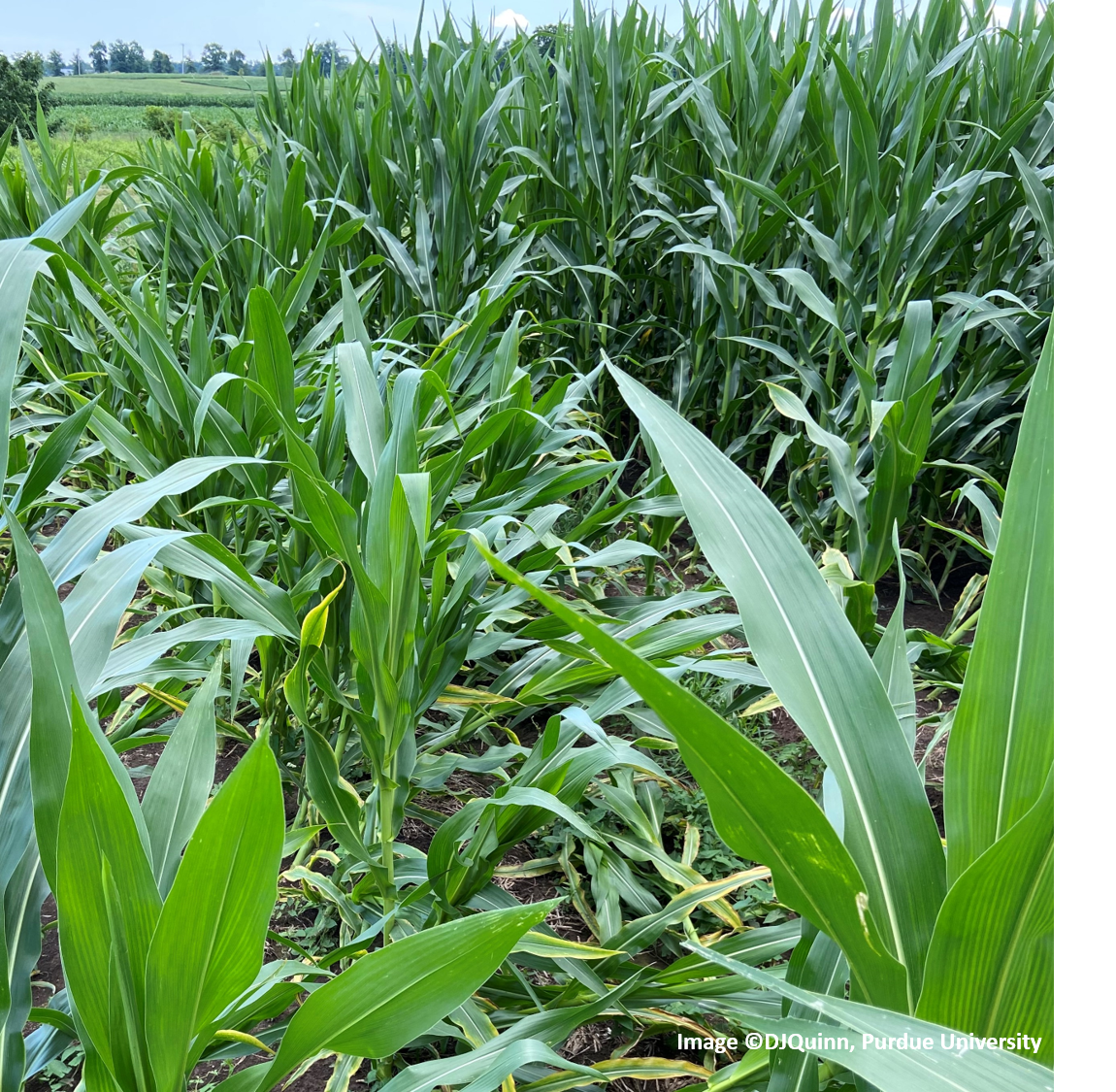Recent storms that have crossed parts of Indiana have brought excessive winds which has resulted in corn being “flattened” from lodging or leaning in certain areas of the state. At first sight, corn that has fallen over can be daunting to look at, and cause some serious concern on what may happen next. Assessing the potential damage and impact on grain yield can be challenging. Therefore, it is important to be patient and wait at least 4 days to allow damaged corn plants to produce visual signs of whether or not they may recover (Nielsen, 2013). Symptoms of recovery can be shown by plants beginning to right themselves upward, the re-establishment of roots, and the re-orienting and growth of leaves. The overall severity and recovery potential for corn can depend on the growth stage of the plant, soil moisture at the time of the wind event, root mass structure, hybrid planted, and the severity of the leaning or bending of the plants (Rees et al., 2020).
The majority of corn in Indiana is currently in the rapid growth phase. Therefore, the crop is particularly vulnerable from damage caused by strong winds, especially in the latter period of the rapid growth phase from about the V8 growth stage and more so as pollination is approached. During this time, elongation of stalk internodes (stalk tissue between the nodes or joints) occurs rapidly (Nielsen, 2013). When this rapid elongation occurs, it often outpaces the lignification (strength and reinforcement) of the stalk tissue. Therefore, the faster the growth, the more susceptible plants are to wind damage.
Leaning or lodging of the corn plant occurs when the plant essentially bends or ‘lays down’ without the stalk breaking. Although this symptom can look devastating, this symptom often causes minimal damage. The majority of plants should re-orient themselves upright, and if this recovery occurs prior to corn pollination, little impact on pollination success will be observed. Corn plants have been shown to upright themselves fairly quickly (~ 3-4 days) after an initial wind event when in the rapid growth phase. However, if a plant can’t reorient itself properly, some leaves can become shaded and a reduction in photosynthesis can occur. Furthermore, if this damage occurs close to the beginning of pollination, the leaves of neighboring, lodged plants may shade or cover some of the exposed silks, thus causing poor pollination.
“Root lodging” of corn can occur with strong winds and high soil moisture levels that results in corn roots being pulled out of the soil. Following this lodging, roots without soil contact may reduce water and nutrient uptake of the corn plant. This symptom can also highlight poor early-season root development (wet soils, side-wall compaction, insect feeding). Root-lodged corn plants that are still in the vegetative phase of growth and within the process of stalk elongation can recover by bending or “goose-necking” to become upright again. If soil moisture is adequate for root growth, if leaves can still intercept sunlight, and plants have adequate time to upright themselves to place silking ears in proper position prior to pollination, flattened corn fields can recover well and yield loss will be minimal. However, the later in vegetative growth period this lodging occurs, the less flexibility the stalks have to reorient themselves properly, and there is a greater chance that pollination and yield will be impacted (Nafziger, 2011).

Image 1: Root-lodged corn following high winds from a thunderstorm in the summer of 2020. (Photo Credit: Dan Quinn)
The most significant damage that can happen to a corn plant following a storm is if stalks are broken or “green-snapping” occurs. But, before deciding how severe the damage from a snapped stalk may be, it is important to identify where on the stalk the breakage occurred. Plants that snap above the harvestable ear, can still produce an ear, however yield will likely be lower than desired and neighboring plants that are snapped may cause shading and reduce potential ear size. Green-snap below the harvestable ear is much more severe and results in direct loss of yield potential. Research has shown that corn yield can be reduced by 0.5 to 1% per 1% of plants that are broken or green-snapped (Elmore and Ferguson, 1999; Rees et. al., 2020).
Overall, it is important remain patient (which is difficult) as corn plants begin to shown signs of recovery. Yield loss from flattened corn is often not as severe as the appearance of the crop following a significant wind event. It can also be difficult to determine specific yield losses following these events. Corn can show fascinating resiliency in trying to survive and reproduce. Furthermore, the majority of corn in Indiana at this time is currently in the rapid growth phase, with plenty of time to recover if it has fallen over. In addition, dry conditions prior to this rain has encouraged roots to proliferate and grow deeper, meaning the majority of the corn in the state was well-anchored at the time of these storms.
References
Nafziger, E., 2011. Wind Damage in Corn. The Bulletin, University of Illinois Extension. http://bulletin.ipm.illinois.edu/article.php?id=1534
Nafziger, E. 2016. Storm Damage in Corn. FarmDoc. University of Illinois Extension. https://farmdoc.illinois.edu/field-crop-production/uncategorized/storm-damage-in-corn.html
Nielsen, R.L. 2011. An Example of “Recovery” from Severe Root Lodging. Corny News Network, Purdue Extension.
https://www.agry.purdue.edu/ext/corn/news/articles.11/FlatCorn-0728.html
Nielsen, R.L. 2013. Damage to Corn Plants by Strong Winds. Corny News Network, Purdue Extension.
https://www.agry.purdue.edu/ext/corn/news/articles.13/WindDamage-0712.html
Rees, J., R. Elmore, and A. Dutcher. 2020. Wind-Damage to Corn. CropWatch. University of Nebraska-Lincoln Extension. https://cropwatch.unl.edu/2020/wind-damage-corn
Thomison, P. 2017. Wind Damage in Corn – “Green Snap” and Root Lodging. C.O.R.N. Newsletter. Agronomic Crops Network. Ohio State University Extension.
https://agcrops.osu.edu/newsletter/corn-newsletter/2017-21/wind-damage-corn-%E2%80%9Cgreen-snap%E2%80%9D-and-root-lodging


